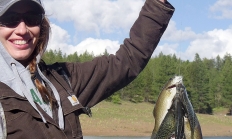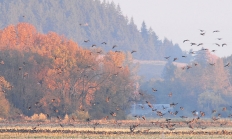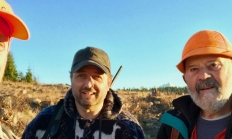
Search myodfw.com
New grant opportunity to build wildlife crossings in Oregon; OCRF seeks letters of interest for Wildlife Passage Infrastructure Projects
Reva Gillman, (541) 961-8421, odfw.ocrf@odfw.oregon.gov
SALEM, Ore. – The Oregon Conservation and Recreation Fund (OCRF) is now accepting letters of interest for its summer 2025 Wildlife Crossing Infrastructure Grant Opportunity, supporting capital construction projects that reduce wildlife-vehicle collisions and restore critical movement and migration pathways across Oregon.
Letters of Interest must be submitted before 11:59 p.m., on July 11, 2025.
(Letter of Interest – Word document)
(Letter of Interest – PDF version)
The grant opportunity seeks to identify shovel-ready projects that include the construction or significant improvement of wildlife crossing infrastructure – such as bridges, culverts, overpasses, or tunnels – on Oregon roadways.
Proposals should be prepared for quick implementation, and funds must be expended by April 30, 2028.
Eligible projects:
- Wildlife passage infrastructure capital construction or improvement projects.
- Projects MUST include construction or significant improvement of a wildlife crossing infrastructure (e.g., bridge, culvert, overpass, tunnel) on a roadway. Related expenses such as engineering design and permitting are allowable.
- Monitoring and maintenance activities must be excluded from proposals or supported using other sources.
- No standalone projects for feasibility studies, site selection, or design are allowed.
OCRF has funded three major wildlife crossing projects so far; the Palensky Wildlife Underpass which was designed for Northern Red-legged Frogs and other native amphibians, the Cackler Marsh bridge to aid beaver and northwestern pond turtle, and the wildlife pathway at the Mt. Ashland I-5 exit to benefit black-tailed deer and increase the diversity of species able to safely pass under the interstate.
Construction of the Palensky Wildlife Underpass was completed in late 2024, and the first seven months of monitoring shows the structure is already being used by dozens of small wildlife species, including salamanders, treefrogs, voles, shrews, snakes, lizards, and hundreds of individual Northern Red-legged Frogs.
"These wildlife crossing structures are critical to reducing wildlife mortality from vehicle strikes," said Rachel Wheat, ODFW Wildlife Connectivity Coordinator. "The fact that so many species are using the Palensky crossing so quickly following construction illustrates how effective and needed these projects are."
For any questions on this grant opportunity, please email odfw.ocrf@odfw.oregon.gov or call 541-961-8421.
###
Photos available:
A Northern Red-legged Frog uses the Palensky Wildlife Underpass, 2025. ODFW Photo.
Aerial view of the Palensky Wildlife Underpass off Hwy. 30 near Portland, Ore. Photo by CREST.
Deadline extension: Grant opportunity to build wildlife crossings in Oregon OCRF seeks letters of interest for Wildlife Passage Infrastructure Projects
Reva Gillman, (541) 961-8421, odfw.ocrf@odfw.oregon.gov

SALEM, Ore. – ODFW's Oregon Conservation and Recreation Fund (OCRF) is now accepting letters of interest for its summer 2025 Wildlife Crossing Infrastructure Grant Opportunity, supporting capital construction projects that reduce wildlife-vehicle collisions and restore critical movement and migration pathways across Oregon.
Letters of Interest must be submitted before 11:59 p.m., on Sept. 19, 2025.
- Letter of Interest – Word document
- Letter of Interest – PDF version
The grant opportunity seeks to identify shovel-ready projects that include the construction or significant improvement of wildlife crossing infrastructure – such as bridges, culverts, overpasses, or tunnels – on Oregon roadways.
Proposals should be prepared for quick implementation, and funds must be expended by April 30, 2028.
Eligible projects:
- Wildlife passage infrastructure capital construction or improvement projects.
- Projects MUST include construction or significant improvement of a wildlife crossing infrastructure (e.g., bridge, culvert, overpass, tunnel) on a roadway. Related expenses such as engineering design and permitting are allowable.
- Monitoring and maintenance activities must be excluded from proposals or supported using other sources.
- No standalone projects for feasibility studies, site selection, or design are allowed.

OCRF has funded three major wildlife crossing projects so far; the Palensky Wildlife Underpass which was designed for northern red-legged frogs and other native amphibians, the Cackler Marsh bridge to aid beaver and northwestern pond turtle, and the wildlife pathway at the Mt. Ashland I-5 exit to benefit black-tailed deer and increase the diversity of species able to safely pass under the interstate.
Construction of the Palensky Wildlife Underpass was completed in late 2024, and the first seven months of monitoring shows the structure is already being used by dozens of small wildlife species, including salamanders, treefrogs, voles, shrews, snakes, lizards, and hundreds of individual northern red-legged frogs.
"These wildlife crossing structures are critical to reducing wildlife mortality from vehicle strikes," said Rachel Wheat, ODFW Wildlife Connectivity Coordinator. "The fact that so many species are using the Palensky crossing so quickly following construction illustrates how effective and needed these projects are."
For any questions on this grant opportunity, please email odfw.ocrf@odfw.oregon.gov or call 541-961-8421.
Photos:
A Northern red-legged frog uses the Palensky Wildlife Underpass, 2025. ODFW Photo.
Aerial view of the Palensky Wildlife Underpass off Hwy. 30 near Portland, Ore. Photo by CREST.


Give space to elk and deer - calf and fawn season is here
Beth Quillian, beth.s.quillian@odfw.oregon.gov, (503) 804-0841
SALEM, Ore. – Oregon's deer and elk give birth from May through July each year. It's natural for mother animals to leave their young alone for extended periods of time while they go off to feed. If you come across a fawn or calf by itself, don't assume it's orphaned. The mother is likely nearby and will return once the area is free of people, pets, or predators.
ODFW regularly receives calls from well-intentioned people who have picked up a fawn thinking it was abandoned or orphaned. What does ODFW tell them? Put it back where you found it.
When people remove them from the wild, young animals miss the chance to learn where to seek cover, what to eat and how to escape from predators and other dangers. The time young animals spend with their parents and in their natural environment is crucial for the development of their long-term survival skills.
Removing an animal from the wild is also a violation of Oregon wildlife laws. (ORS 497.308 – No person shall remove from its natural habitat or acquire and hold in captivity any live wildlife in violation of the wildlife laws.)
Fawns and calves are most vulnerable to predators in their first few weeks of life when they can't keep up with the adults. To avoid calling attention to their offspring, mothers will hide their young in brush and leave to forage for food, sometimes for long periods. A fawn or calf's spotted coat helps camouflage them as they stay motionless. They also have very little odor as another protection against attracting predators.
Picking up wildlife causes more harm than good If you see a fawn alone, leave it where it is - its mother is likely nearby. The hard truth is that removing a fawn from the wild almost immediately reduces its chances of survival to zero. Deer do not abandon their fawns. A doe invests months of energy into raising her young and will go to great lengths to find her fawn when she returns from foraging, often searching the area extensively.
If you encounter deer or elk, especially with young, give them space and enjoy viewing from a distance. If your presence disturbs wildlife, you're too close.
Keep pets leashed and away from wildlife Deer and elk see dogs as a threat and may respond aggressively to protect their young. Female elk with young calves have injured and killed pets in Oregon and Washington. It is their instinct to protect their young.
Roosevelt elk are the largest elk subspecies in terms of body size, with bulls generally weighing 700-1,100 pounds. Cow elk will aggressively protect their young in the spring and summer. Bull elk become especially aggressive during the fall rut when they challenge other males and will charge anything that comes too close.



Turkey anatomy plays a big part in determining shot placement with a bow. Knowing where vital organs like the heart and lungs are will help you make a clean shot. Sometime getting to the vital organs may mean going through bone. In fact, a shot to the spine will drop a turkey quickly. But turkey bones are very strong, despite being hollow. That’s why many experienced archers prefer shooting a bow with a heavy draw weight, often the same setup they use for deer and elk hunting. Head shots, the most popular turkey shot for shotgun hunters, should be avoided


Build a wood duck house to encourage nesting. Walk a stream counting steelhead redds. Teach families to fish. Just some of the things ODFW volunteers do to help protect and enhance Oregon's natural resources. Current volunteer opportunities



May 29, 2025 Tillamook County Birds Northward migrants should be visible during March as they make their way back towards breeding grounds in Alaska and beyond. Many species of shorebirds and some waterfowl are only likely to be sighted for a few short weeks in the spring and fall as they travel between winter and summer locations. Different species of shorebirds will use rocky and sandy ocean shorelines, upper and lower estuaries, fields and riverbanks/gravel bars as they move through the area. Most will eventually move on to breeding grounds in Alaska and western Canada. Likewise, the large numbers of

May 29, 2025 Crook County There are red-tailed, rough-legged and ferruginous hawks, northern harriers, American kestrels, prairie falcons and golden eagles throughout Crook County and they're usually associated more closely with open/agricultural areas. Bald eagles and osprey, on the other hand, are more closely associated with water bodies. Look for northern goshawks throughout the Ochoco National Forest, and for ducklings and goslings in rivers and lakes. Prineville Reservoir Wildlife Area The Prineville Reservoir Wildlife Area offers access to view a wide variety of wildlife, including deer, coyotes, otter, beaver, raptors, shorebirds and waterfowl. Maps of the wildlife area are available


